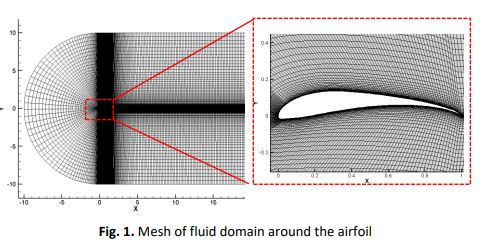Numerical Investigations of Aerodynamic Characteristics Prediction of High-lift Low Reynolds Number Airfoil
DOI:
https://doi.org/10.37934/cfdl.14.2.111121Keywords:
Low Reynolds number, High-lift Airfoils, Turbulence ModelsAbstract
The Micro Aerial Vehicles (MAVs) operate at a critical range of low Reynolds number (Re). The implementation of the low (Re) aerodynamics for MAVs has brought interest into the study of high-lift low Re airfoils. Such investigations may bring new insight into the aerodynamic performance of MAVs flights. The aim of the current investigation is to exam different numerical methods in the aerodynamics prediction of high-lift low Reynolds number S1223 airfoil. For that purpose, the Spallart Allmaras (S-A), two equations SST K-ω and the four equations transition γ-Reθ SST turbulence models were used. Results revealed that the SA turbulence model can predict the pre-stall low angles of attack and provides a good agreement with experimental data and XFOIL results. Whereas the two-equation model SST-enhanced K-ɷ and the transition SST models predict better the unsteadiness of the stall behaviour. XFoil accurately predicts the highest lift coefficient, even if it occurs at a lower angle of attack. These results showed the promising ability of the transition SST selection in predicting the stall behaviour.
Downloads
References
Michelson, R. C. Micro Air Vehicles. In Handbook of Unmanned Aerial Vehicles (K. P. Valavanis and G. J. Vachtsevanos, eds.), Springer Netherlands, Dordrecht, 2015, pp. 1305–1310.
Wauters, Jolan, and Joris Degroote. "On the study of transitional low-Reynolds number flows over airfoils operating at high angles of attack and their prediction using transitional turbulence models." Progress in Aerospace Sciences 103 (2018): 52-68. https://doi.org/10.1016/j.paerosci.2018.10.004.
Morgado, J., R. Vizinho, M. A. R. Silvestre, and J. C. Páscoa. "XFOIL vs CFD performance predictions for high lift low Reynolds number airfoils." Aerospace Science and Technology 52 (2016): 207-214. https://doi.org/10.1016/j.ast.2016.02.031.
Aftab, S. M. A., A. S. Mohd Rafie, N. A. Razak, and K. A. Ahmad. "Turbulence model selection for low Reynolds number flows." PloS one 11, no. 4 (2016): e0153755. https://doi.org/10.1371/journal.pone.0153755.
Dong, Hao, Tianyu Xia, Lin Chen, Shicheng Liu, Y. D. Cui, B. C. Khoo, and Aihong Zhao. "Study on flow separation and transition of the airfoil in low Reynolds number." Physics of Fluids 31, no. 10 (2019): 103601. https://doi.org/10.1063/1.5118736.
Wortmann, F. "The quest for high-lift." In 2nd International Symposium on the Technology and Science of Low Speed and Motorless Flight, p. 1018. 1974. https://doi.org/10.2514/6.1974-1018.
Ibrahim, Che Intan Hartini Che, and Aslam Abdullah. "Flow Topology around Low Reynolds Number Airfoils with Vortex Shedding." CFD Letters 12, no. 12 (2020): 85-103. https://doi.org/10.37934/cfdl.12.12.85103.
Selig, M. S., Guglielmo, J. J., Broeren, A. P., and Giguère, P. Summary of Low Speed Airfoil Dara - Vol 1. 1995.
Selig, Michael S., and James J. Guglielmo. "High-lift low Reynolds number airfoil design." Journal of aircraft 34, no. 1 (1997): 72-79. https://doi.org/10.2514/2.2137.
Jameel, A., S. Khalid, M. Khan, K. Kamal, A. Aqeel, S. Mathavan, T. Awais, and T. Zafar. "A Bio inspired UAV model based on Corvus Splendens." In 2015 International Conference on Fluid Power and Mechatronics (FPM), pp. 797-802. IEEE, 2015.
Zohary, Aideal Czar, Waqar Asrar, and Mohammed Aldheeb. "Numerical Investigation on the Pressure Drag of Some Low-Speed Airfoils for UAV Application." CFD Letters 13, no. 2 (2021): 29-48. https://doi.org/10.37934/cfdl.13.2.2948.
SPALART, P., and ALLMARAS, S. A One-Equation Turbulence Model for Aerodynamic Flows. 1992.
Menter, Florian R. "Two-equation eddy-viscosity turbulence models for engineering applications." AIAA journal 32, no. 8 (1994): 1598-1605. https://doi.org/10.2514/3.12149.
Langtry, Robin B., and Florian R. Menter. "Correlation-based transition modeling for unstructured parallelized computational fluid dynamics codes." AIAA journal 47, no. 12 (2009): 2894-2906. https://doi.org/10.2514/1.42362.
Xia, Tianyu, Hao Dong, Liming Yang, Shicheng Liu, and Zhou Jin. "Investigation on flow structure and aerodynamic characteristics over an airfoil at low Reynolds number—A review." AIP Advances 11, no. 5 (2021): 050701. https://doi.org/10.1063/5.0044717.
Drela, M. XFOIL: An Analysis and Design System for Low Reynolds Number Airfoils. In Low Reynolds Number Aerodynamics. Proc. Conf., Notre Dame, U.S.a., June 5-7, 1989 }Edited By T.J. Mueller]. (Lecture Notes in, 1989, pp. 1–12.
Storms, Bruce L., and Cory S. Jang. "Lift enhancement of an airfoil using a Gurney flap and vortex generators." Journal of Aircraft 31, no. 3 (1994): 542-547. https://doi.org/10.2514/3.46528.
Turbulence Modeling Resource. Langley Research Center Turbulence Modeling Resource. 10. Volume 45, 1–8. https://turbmodels.larc.nasa.gov/naca0012_val.html. Accessed Mar. 2, 2021.




























